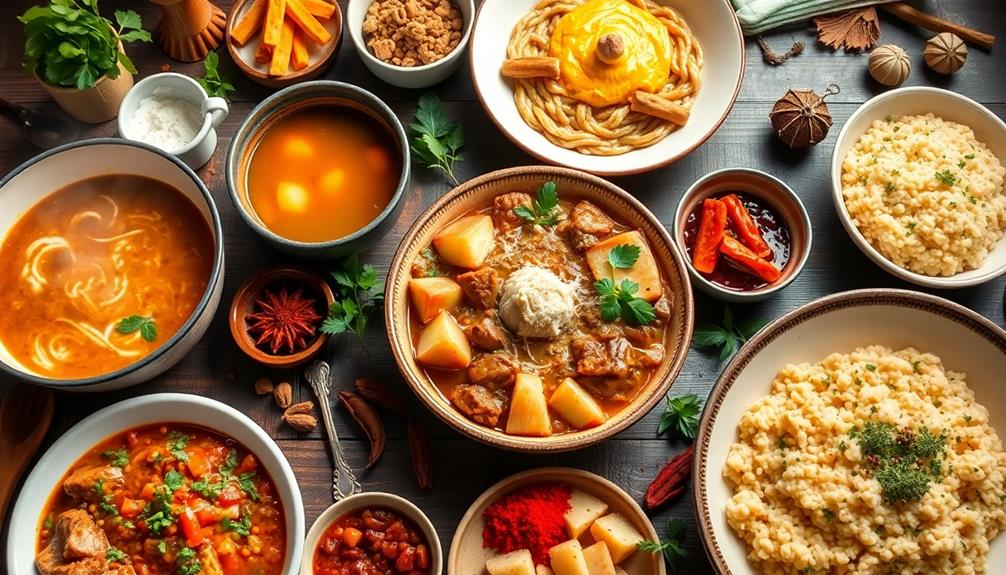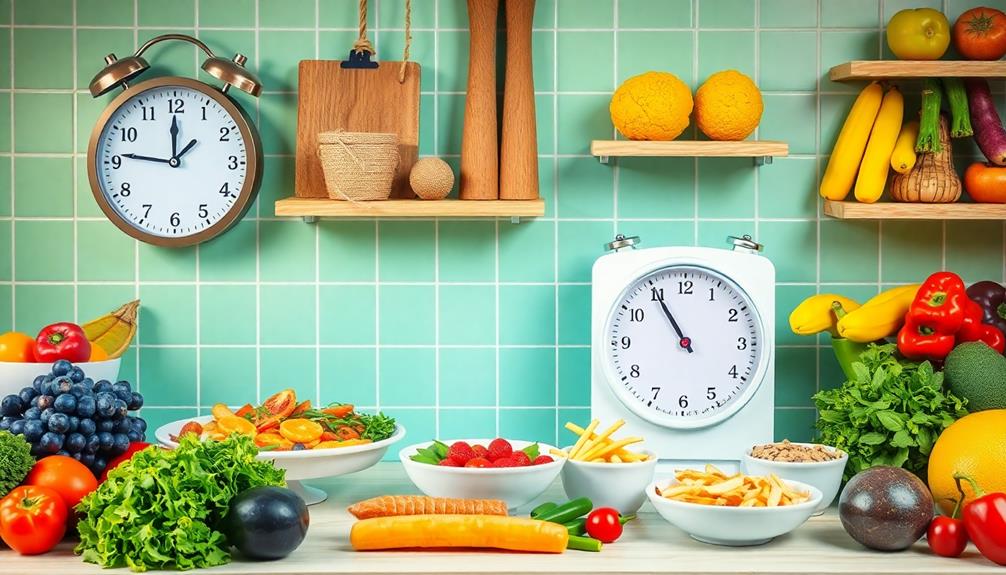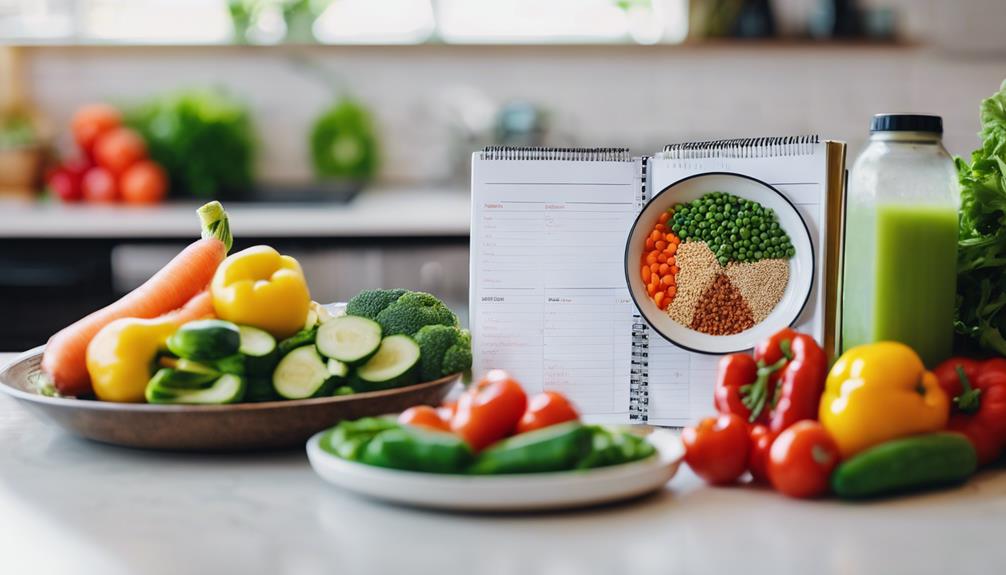Certain foods are linked to specific emotions because they activate your brain's reward system. When you enjoy these foods, dopamine releases, giving you pleasure and satisfaction. If you're feeling stressed or anxious, you might crave comforting meals that hold nostalgic value. These dishes often remind you of positive experiences, such as family gatherings. Additionally, your cultural background shapes your comfort food choices, reflecting collective memories and flavors that resonate with you. Understanding these connections can help you make healthier choices. Explore how emotional triggers influence your eating habits and what you can do to foster a more balanced relationship with food.
Key Takeaways
- Comfort foods trigger dopamine release, activating the brain's reward system and enhancing feelings of pleasure and satisfaction during consumption.
- Nostalgia shapes food preferences, guiding individuals toward dishes that evoke positive emotions and memories from their past.
- Cultural traditions influence comfort food choices, reflecting shared experiences and evoking feelings of safety and care associated with family gatherings.
- Emotional eating often arises from stress and anxiety, causing cravings for high-calorie foods that offer temporary relief but can lead to negative health outcomes.
- Mindful eating practices help individuals recognize emotional triggers, promoting healthier choices and reducing the likelihood of overeating during emotional distress.
Psychological Basis of Food Emotions

When you indulge in your favorite comfort food, it's more than just satisfying hunger; it's an emotional experience rooted in psychology. The strong psychological connection between comfort foods and your emotional states stems from how the brain's reward system activates during consumption.
As you savor those creamy textures and rich flavors, your brain releases dopamine, leading to pleasure and satisfaction. This response can be particularly powerful when you're feeling stressed or anxious, triggering cravings for specific foods that bring you solace.
For example, the rich blend of spices in dishes like Mushroom Masala can evoke feelings of warmth and comfort. Nostalgia plays a critical role in shaping these cravings, as sensory experiences—like the smells and tastes of your childhood favorites—evoke cherished memories of care and safety.
Your comfort food preferences often reflect cultural histories and personal backgrounds, making them unique to you. Shared meals with family and friends can reinforce the emotional significance of these foods, creating collective memories that bind communities together.
Consequently, every bite can transport you back to moments of joy, reminding you of the emotional significance these foods hold in your life. Embracing comfort foods isn't just about taste; it's about reconnecting with your past and finding emotional solace in the present.
The Role of Nostalgia

Nostalgia plays a pivotal role in shaping your food choices, often guiding you toward dishes that evoke cherished memories. You might find yourself reaching for comfort foods that remind you of family gatherings or childhood experiences.
Traditional dishes like Caldeirada or Brigadeiro can hold special significance, as they often trigger emotional responses and enhance positive emotions like happiness and security, especially during stressful times.
When you indulge in these nostalgic dishes, you're not just satisfying hunger; you're also taking a psychological retreat to moments that provided care and safety. These meals often represent shared experiences, reinforcing bonds with loved ones and cultivating a sense of belonging.
Cultural variations in comfort foods highlight how collective memories influence individual preferences. Traditional dishes unique to your culture can evoke nostalgia, connecting you to your roots and the people who share those memories.
Ultimately, nostalgia transforms food choices into a powerful emotional experience, allowing you to relive moments that shaped your identity. The interplay between memories and food deepens interpersonal relationships, making every meal an opportunity to reconnect with the past and those you cherish.
Cultural Influences on Comfort Foods

Cultural influences shape your comfort food choices, highlighting the diversity of flavors and traditions that vary around the world. These foods often embody emotional connections tied to family traditions and shared meals during cultural celebrations. Think about how grits and biscuits in the American South evoke nostalgia for family gatherings, while miso soup in Japan brings warmth and comfort during cold winters. Similarly, cultural norms and expectations often intersect with gender stereotypes in food choices, influencing what people perceive as appropriate or desirable to eat. For instance, hearty or protein-heavy meals like steaks are often marketed as masculine, while lighter options like salads are frequently associated with femininity. These stereotypes not only affect how individuals select comfort foods but also how they connect with their cultural identities through eating habits.
Here's a glimpse into how different cultures interpret comfort foods:
| Culture | Comfort Food |
|---|---|
| American South | Grits and Biscuits |
| Japan | Miso Soup |
| Italy | Risotto |
| India | Chicken Curry |
| Mexico | Tamales |
These culinary practices create sensory experiences that remind you of care and safety. Emotional well-being often hinges on these dishes, as they reinforce bonds with loved ones. The significance of comfort foods lies in their ability to connect you to treasured memories, making them an essential part of cultural identity. Ultimately, the flavors you cherish today are rooted in traditions that span generations, enriching your emotional landscape.
Health Implications of Emotional Eating

Emotional eating impacts your health considerably, often leading to poor dietary choices that can contribute to chronic diseases. When you turn to food in response to negative emotions like stress, depression, or loneliness, you're likely to reach for unhealthy eating options.
For instance, the comfort of rich dishes such as Red-Braised Pork Belly can sometimes lead to overindulgence during emotionally challenging times. This pattern can escalate, as research shows a significant association between emotional states and increased food intake, particularly high-calorie, sugary foods.
Over time, this cycle can lead to weight gain and exacerbate psychological health issues, creating a feedback loop that's hard to break. A sustained positive energy balance, often a result of emotional eating, underscores the challenges in managing weight and highlights obesity as a diet-related health issue.
To combat the health implications of emotional eating, it's essential to focus on maintaining a balanced diet filled with healthier foods. By recognizing your emotional states and their influence on your eating habits, you can take steps to make healthier choices.
Awareness is key; understanding how your emotions drive your food intake can empower you to adopt better coping mechanisms, ultimately supporting both your physical and psychological health.
Strategies for Healthier Eating Choices

Making healthier eating choices starts with understanding the impact of your food selections on both your body and mind. If you're an emotional eater, recognizing your triggers is essential. Using a food journal can help you identify patterns that lead to unhealthy eating habits.
Consider these strategies to improve your food choices:
| Strategy | Description | Benefits |
|---|---|---|
| Whole Grains | Swap refined grains for whole grains | Enhances emotional well-being |
| Healthy Alternatives | Choose lean proteins over comfort foods | Satisfies cravings while promoting balance |
| Mindful Eating | Focus on the sensory experience of food | Increases satisfaction, reduces overeating |
| Regular Physical Activity | Engage in exercise to manage stress | Supports healthy eating behaviors |
| Balanced Diet | Incorporate nutrient-rich foods | Supports brain health and mood regulation |
Frequently Asked Questions
How Is Food Connected to Emotions?
Food connects to your emotions through memories and experiences. When you eat something comforting, it often triggers feelings of nostalgia or satisfaction, helping you cope with stress or loneliness while evoking a sense of belonging.
Can Certain Foods Make You Emotional?
Absolutely, certain foods can make you emotional. When you indulge in a favorite dish, it can trigger memories or feelings of comfort, leading you to experience joy, nostalgia, or even sadness in that moment.
What Influences Your Food Choices Food and Emotions?
Your food choices are influenced by cravings, sensory experiences, and emotional states. When you feel stressed or nostalgic, you often reach for comforting dishes that evoke memories, providing temporary relief and satisfaction during tough times.
How Is Food Linked With Our Mental and Emotional Wellbeing?
Food's like a canvas, painting your mental landscape. When you choose nourishing meals, you're crafting a brighter mood. But when you indulge in sugary treats, you might find shadows creeping back into your emotional well-being.
Conclusion
Next time you savor a warm bowl of mac and cheese or bite into a sweet chocolate bar, remember the emotions they stir within you. Those flavors can transport you to cozy childhood kitchens or festive family gatherings. By understanding the links between food and feelings, you can take charge of your cravings, choosing vibrant fruits or crunchy veggies that nourish both body and soul. Embrace the journey of mindful eating, and let your plate reflect joy without guilt.










